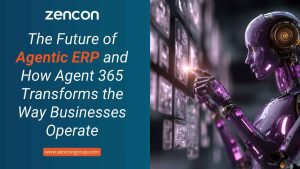For most organizations today, the question isn’t if they should move their ERP to the cloud, it’s when and how.
Legacy systems that once felt reliable are now holding businesses back from agility, speed, and real-time decision-making.
The move to a cloud-based ERP platform like Microsoft Dynamics 365 isn’t just an IT project. It’s a strategic business shift that impacts how every part of an organization operates.
1. Why the shift to cloud ERP is accelerating
The global cloud ERP market surpassed $34 billion in 2023 and is expected to grow nearly 18% annually through 2030.
This growth isn’t just a trend. It’s a reflection of real business value.
- A Nucleus Research study found an average 3.8:1 return on investment for cloud migrations.
- Over half of organizations have already migrated most of their IT workloads to the cloud.
- Companies that adopted cloud ERP report a 91% improvement in inventory management and 62% reduction in operating costs.
Businesses are realizing that maintaining old systems costs more than modernizing them. Cloud ERP brings flexibility, scalability, and security that legacy systems simply can’t match.
2. What cloud ERP actually changes
Moving ERP to the cloud isn’t only about hosting data elsewhere. It fundamentally changes how your teams work.
Real-time visibility and agility
Instead of relying on outdated reports, leaders see accurate insights in real time, enabling faster and smarter decisions.
Scalability on demand
Whether you’re expanding to new regions or launching new product lines, cloud infrastructure scales automatically without added complexity.
Predictable cost structure
The traditional model of heavy upfront investment is replaced by flexible, pay-as-you-go subscriptions that align spending with actual use.
Security and compliance by design
Leading cloud platforms apply continuous updates and multi-layer security, ensuring compliance and resilience without internal IT overhead.
Integration-ready foundation
Cloud ERP easily connects with AI, automation, and analytics tools like Power BI, enabling companies to innovate faster.
3. How it transforms business outcomes
Cloud ERP isn’t just a technical upgrade. It’s a shift in business performance and decision-making.
- Finance teams gain predictive insights instead of waiting for reports
- Operations detect and solve bottlenecks before they become disruptions
- Sales and service teams collaborate with one shared view of the customer
- Executives manage from data, not intuition
These outcomes turn information into intelligence, giving every department the ability to act with clarity and precision.
4. What makes migration successful
A successful cloud migration depends on process discipline, stakeholder alignment, and realistic rollout planning.
Clean process and data structure
Outdated workflows and inconsistent data cause most ERP failures. Clean them before migration begins.
Change management and user training
The best technology fails if people resist it. Ongoing communication, workshops, and role-based training are key.
Phased implementation
Rolling out modules in stages helps minimize risk, deliver faster wins, and ensure smoother adoption.
Continuous improvement
After go-live, continuous optimization ensures the ERP keeps up with business evolution and performance goals.
5. Proven results from ERP modernization
Organizations that have already moved to the cloud consistently report measurable gains:
- 35% faster financial close cycles
- 25% lower operational costs
- 50% better visibility across supply chains
- Noticeably reduced IT maintenance hours
These results are not theoretical. They come from businesses that replaced fragmented systems with a single, connected source of truth.
6. The takeaway
Cloud ERP is no longer an upgrade to consider someday. It is the digital core of a modern, intelligent business.
It gives companies the speed to respond, the data to decide, and the freedom to grow without technology getting in the way.
The real question is no longer whether to move to the cloud, but how soon your organization wants to experience the difference.



